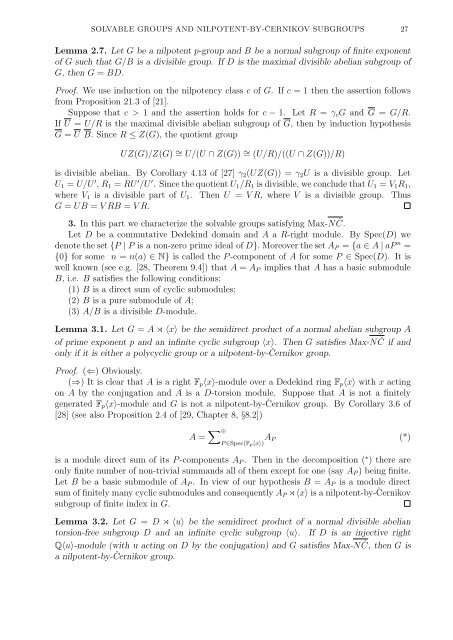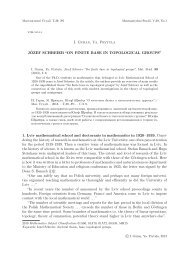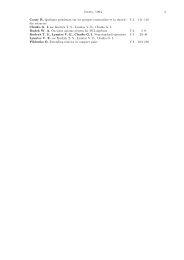SOLVABLE GROUPS WITH MANY CONDITIONS ON NILPOTENT ...
SOLVABLE GROUPS WITH MANY CONDITIONS ON NILPOTENT ...
SOLVABLE GROUPS WITH MANY CONDITIONS ON NILPOTENT ...
Create successful ePaper yourself
Turn your PDF publications into a flip-book with our unique Google optimized e-Paper software.
<strong>SOLVABLE</strong> <strong>GROUPS</strong> AND <strong>NILPOTENT</strong>-BY-ČERNIKOV SUB<strong>GROUPS</strong> 27<br />
Lemma 2.7. Let G be a nilpotent p-group and B be a normal subgroup of finite exponent<br />
of G such that G/B is a divisible group. If D is the maximal divisible abelian subgroup of<br />
G, then G = BD.<br />
Proof. We use induction on the nilpotency class c of G. If c = 1 then the assertion follows<br />
from Proposition 21.3 of [21].<br />
Suppose that c > 1 and the assertion holds for c − 1. Let R = γ c G and G = G/R.<br />
If U = U/R is the maximal divisible abelian subgroup of G, then by induction hypothesis<br />
G = U B. Since R ≤ Z(G), the quotient group<br />
UZ(G)/Z(G) ∼ = U/(U ∩ Z(G)) ∼ = (U/R)/((U ∩ Z(G))/R)<br />
is divisible abelian. By Corollary 4.13 of [27] γ 2 (UZ(G)) = γ 2 U is a divisible group. Let<br />
U 1 = U/U ′ , R 1 = RU ′ /U ′ . Since the quotient U 1 /R 1 is divisible, we conclude that U 1 = V 1 R 1 ,<br />
where V 1 is a divisible part of U 1 . Then U = V R, where V is a divisible group. Thus<br />
G = UB = V RB = V R.<br />
3. In this part we characterize the solvable groups satisfying Max-NČ.<br />
Let D be a commutative Dedekind domain and A a R-right module. By Spec(D) we<br />
denote the set {P | P is a non-zero prime ideal of D}. Moreover the set A P = {a ∈ A | aP n =<br />
{0} for some n = n(a) ∈ N} is called the P -component of A for some P ∈ Spec(D). It is<br />
well known (see e.g. [28, Theorem 9.4]) that A = A P implies that A has a basic submodule<br />
B, i.e. B satisfies the following conditions:<br />
(1) B is a direct sum of cyclic submodules;<br />
(2) B is a pure submodule of A;<br />
(3) A/B is a divisible D-module.<br />
Lemma 3.1. Let G = A ⋊ 〈x〉 be the semidirect product of a normal abelian subgroup A<br />
of prime exponent p and an infinite cyclic subgroup 〈x〉. Then G satisfies Max-NČ if and<br />
only if it is either a polycyclic group or a nilpotent-by-Černikov group.<br />
Proof. (⇐) Obviously.<br />
(⇒) It is clear that A is a right F p 〈x〉-module over a Dedekind ring F p 〈x〉 with x acting<br />
on A by the conjugation and A is a D-torsion module. Suppose that A is not a finitely<br />
generated F p 〈x〉-module and G is not a nilpotent-by-Černikov group. By Corollary 3.6 of<br />
[28] (see also Proposition 2.4 of [29, Chapter 8, §8.2])<br />
A = ∑ ⊕<br />
P ∈Spec(F p〈x〉) A P (*)<br />
is a module direct sum of its P -components A P . Then in the decomposition ( ∗ ) there are<br />
only finite number of non-trivial summands all of them except for one (say A P ) being finite.<br />
Let B be a basic submodule of A P . In view of our hypothesis B = A P is a module direct<br />
sum of finitely many cyclic submodules and consequently A P ⋊〈x〉 is a nilpotent-by-Černikov<br />
subgroup of finite index in G.<br />
Lemma 3.2. Let G = D ⋊ 〈u〉 be the semidirect product of a normal divisible abelian<br />
torsion-free subgroup D and an infinite cyclic subgroup 〈u〉. If D is an injective right<br />
Q〈u〉-module (with u acting on D by the conjugation) and G satisfies Max-NČ, then G is<br />
a nilpotent-by-Černikov group.









